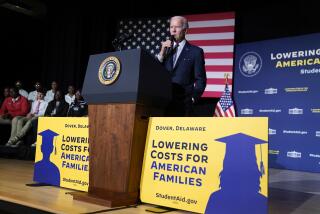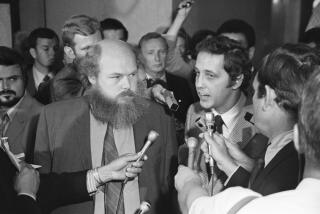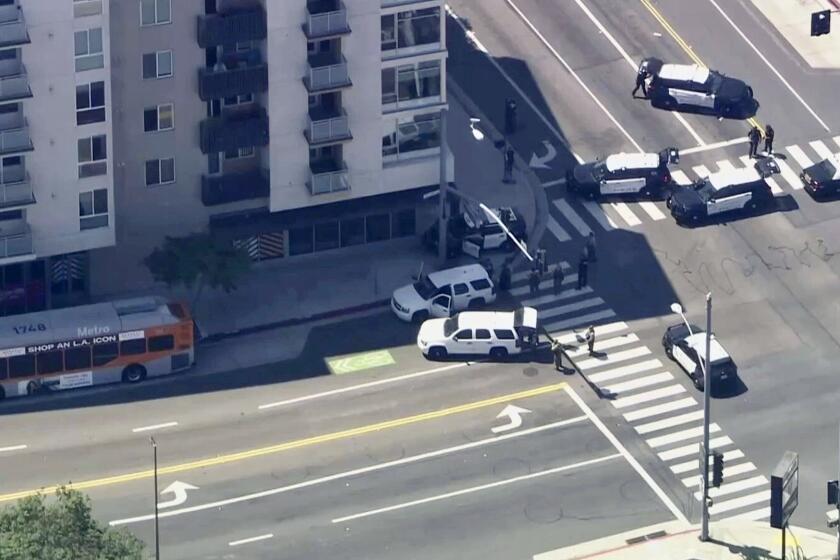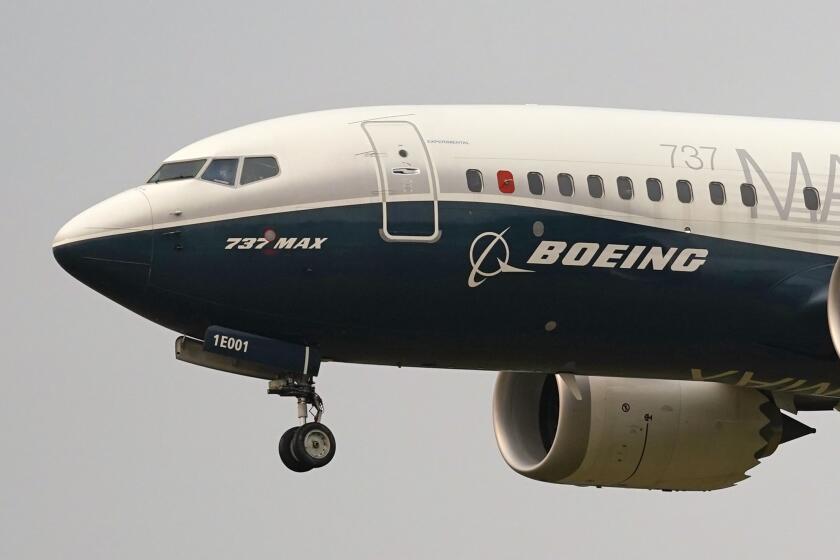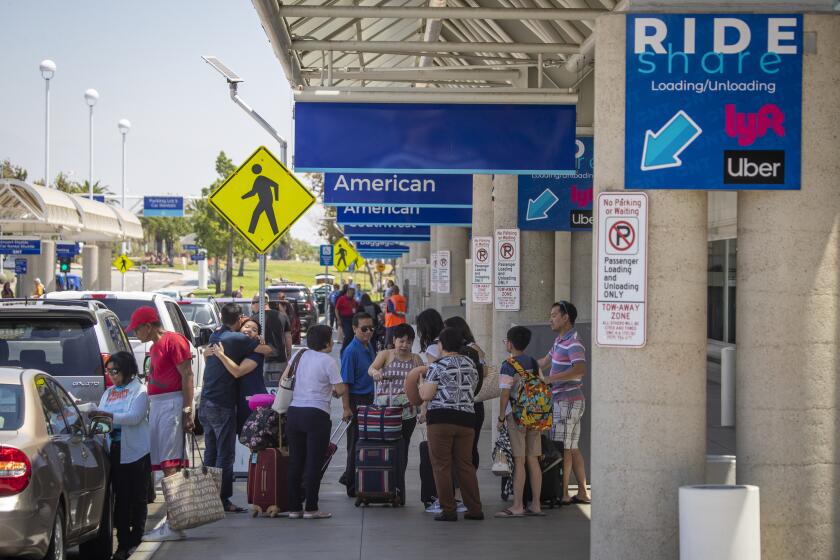An Old Technology Gives New Life to Aging Concrete Roadways
The crews arrive just before midnight in orange vests and yellow hard hats. Working under glaring lights that cast harsh, surreal shadows, they resemble miners in a moonscape. Before departing at dawn, they leave their mark: symmetrical parallel grooves like hieroglyphics in the pavement.
Under contract with the California Department of Transportation, the workers are giving new life to 35-year-old concrete pavement well past its prime, using a technology developed decades ago but recently refined into a process being adopted nationwide.
“What we’re trying to do is extend the life of the road,” said Dan DeBassio, a Caltrans engineer overseeing the restoration of 10 miles of Orange County freeway.
The crews are embedding 18-inch-long metal dowels side by side under the pavement. Since last November, more than 30,000 of the 1 1/2-inch-diameter bars have been buried in the San Diego Freeway from Costa Mesa to Irvine, about half the number planned for a $12-million project there.
Caltrans hopes the bars will prevent the pavement from buckling under the weight of traffic, thus doubling the life of the roadway. “That way it won’t feel like you’re driving over a rumble strip,” DeBassio said.
Experts say the process, called dowel-bar retrofitting, is cheaper and more efficient than the standard practice of replacing old concrete pavement, which accounts for about 20% of the nation’s highways and is built to withstand heavier traffic than asphalt city streets and rural roads.
Though the technology is at least 20 years old, it has recently been reborn.
“Dowel bars are the wave of the future,” said James Woodstrom, a former Caltrans engineer who is now a consultant to the industry’s leading trade group, the American Concrete Paving Assn. “They’re definitely here to stay.”
In the early 1980s, when the dowel concept was developed, most states that considered it--including California--eventually rejected it as ineffective and labor intensive.
A technological breakthrough a decade later dramatically lowered the cost. An engineer for CTI Concrete Textures in Des Moines, Iowa, invented a machine called a slotter to cut deep symmetrical grooves in the pavement that could then be dug out easily with jackhammers, leaving holes in which the steel bars could be placed. With the slotter, the cost is about $380,000 per lane-mile for dowel-bar retrofitting, less than half the $800,000 per mile to replace pavement.
“That’s the thing that made retrofitting possible,” said John Roberts, vice president of pavement restoration for the American Concrete Paving Assn. and an expert on dowel-bar technology. “The machine got the job done. It was the innovative twist that opened the door.”
Washington was the first state to try the streamlined process, retrofitting about 350 miles of highway in the 1990s.
“The main problem here is that we have all this pavement built in the 1960s when who’d have thought that we’d have this much traffic,” said Linda Pierce, that state’s pavement engineer. “Our concrete is 35 years old and falling apart. We can’t afford to reconstruct it, so dowel-bar retrofitting is something we can do to make the public happy.”
California was next, adopting the technique in 1998 after a small test on Interstate 80 near Colfax in Northern California. Five more tests followed, including one on the San Diego Freeway near Orange County’s John Wayne Airport. The state’s first full-blown dowel-bar retrofit took place last year in Pomona. Eight months ago, Caltrans officials in Orange County began using steel dowels to restore the 10-mile, 35-year-old section of freeway from Costa Mesa to Irvine.
“Our concrete is designed to last only 25 to 30 years,” said Karl Smith, Caltrans’ maintenance manager in Sacramento, “and a lot of it has already met or exceeded that.” With dowel-bar retrofitting, he said, the life expectancy of roadways can potentially be doubled.
At least 15 other states are following suit. With much of the nation’s interstate highway system approaching the end of its life span, dowel-bar retrofitting is likely to increase, said Mark Swanlund, a concrete pavement engineer for the Federal Highway Administration.
“It’s the best concrete pavement rehabilitation technique to come along in 20 years,” he said. “It’s a cost-effective solution to a problem that before could only be solved by ripping the pavement out and starting over.”
As testament to the technology’s effectiveness, Swanlund said, every state in the nation now embeds dowel bars in new concrete roads. By laying the metal under the pavement, road builders say, they can “lace” the concrete sections together, dramatically diminishing the tendency of the road to sink or buckle.
That is the goal in Orange County, where employees of Rancho Cucamonga-based Joe McLoughlin Engineering Co., under contract with Caltrans, have deposited tens of thousands of the rods under the pavement since November. Working seven nights a week, they expect to finish the project in late fall.
Work begins about 10 p.m. when Caltrans engineer DeBassio meets with California Highway Patrol officers to coordinate the night’s freeway closure and detours.
“Working so close to traffic is dangerous,” DeBassio said, “because people don’t want to slow down for our signs.”
By narrowing the freeway to one lane in each direction, he said, the safety of workers is assured.
The project has drawn complaints, some from motorists and others from residents bothered by the noise.
“Usually we just explain the project to them and they’re OK,” Caltrans spokeswoman Gail Smith said. One homeowner, however, was not appeased. “He asked us to install double-paned windows through his whole house,” she said. “We declined.”
The carefully choreographed steps in which the doweling is done can be noisy indeed. First, a crew using the slotter, a truck-like contraption with 16 blades underneath, cuts slots in the pavement. A second crew equipped with jackhammers digs out the trenches, which are then sandblasted before workers set each rod in place. Next, the trenches are filled with a cement and gravel mix, which dries a lighter color than the original concrete, leaving a characteristic pattern in the pavement. Finally, the new mix is sanded smooth.
“We have to hustle to be done by 3 a.m.,” when two hours of cleanup begin, DeBassio said. “We have a very small window.”
That means no slack time for the overnight road workers, many of whom wear white dust masks as they scramble across the artificially lighted, unearthly looking pavement.
“We always set goals,” said Ruban Diaz, the crew foreman. “The challenge is running a big group of guys. Everybody works very hard.”
Paving the Way to a Smoother Ride
Caltrans is retrofitting portions of the San Diego Freeway where the pounding of heavy truck traffic causes uneven, damaged pavement joints. The project, an effort to extend the life of the freeway without repaving, began last November and will be completed in November 2001.
* ProblemTrucks pound concrete roadway as weight moves from one slab to the next, battering edges of pavement.
* Solution Dowels tie slabs together and spread weight across multiple sections.
Source: Dan DeBassio, Caltrans engineer
Reporting and graphic by PAUL DUGINSKI / Los Angeles Times
More to Read
Start your day right
Sign up for Essential California for news, features and recommendations from the L.A. Times and beyond in your inbox six days a week.
You may occasionally receive promotional content from the Los Angeles Times.

